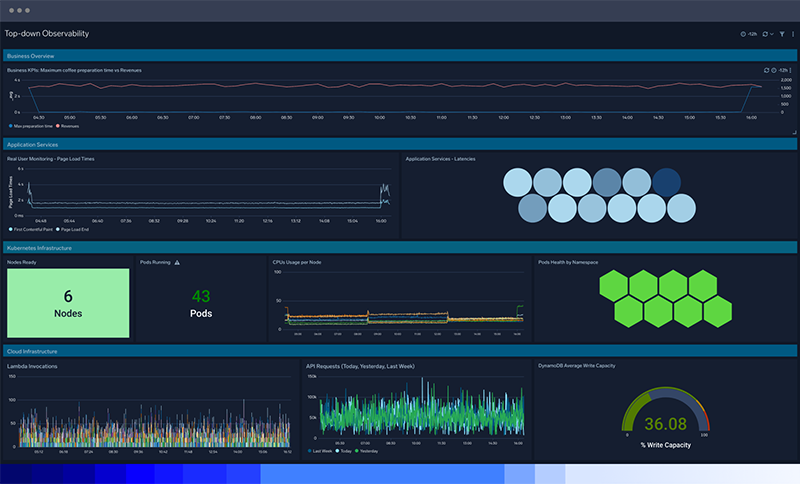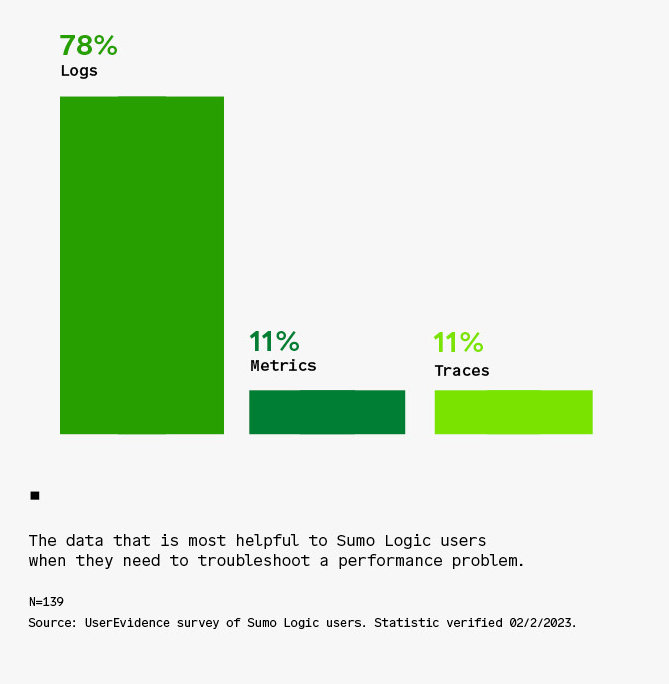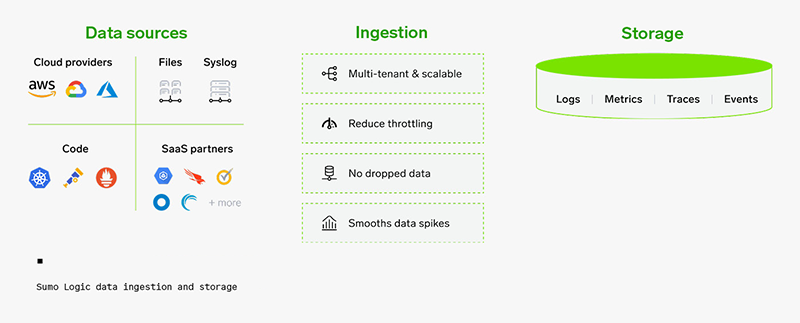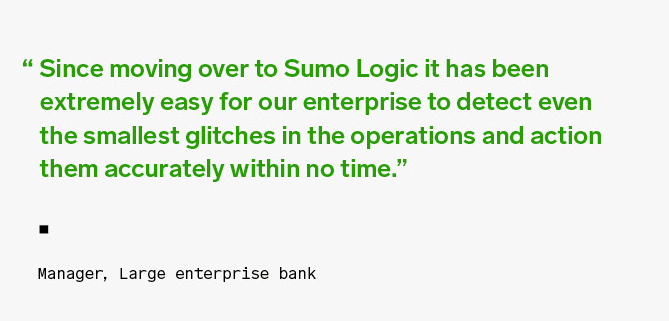
Get the report
MoreFew things are as powerful, as frightening, as overwhelming and as important as data.
Every day, more companies shift to cloud solutions for their critical business applications. While sound log management practices help tame that data, organizations rely on real-time time analytics and actionable insights to ensure the reliability and security of digital experiences.
According to Gartner research, more than half of enterprise IT spending is shifting to cloud-based platforms and products. Especially when it comes to vital business operations, log management — and log analytics — play essential roles. As Gartner puts it:
“Technology and service providers that fail to adapt to the pace of cloud face increasing risk of becoming obsolete or, at best, being relegated to low-growth markets.”
This log analytics overview covers what you need to know and tips for getting started.

Businesses — and the technologies they and their customers rely on — generate data rapidly and from many distinct sources.
In this context, a log or log file is a computer-generated data file that contains information about usage patterns, activities, and operations within an operating system, application, server or another device. These time-stamped digital records document certain actions or events and materialize from several sources, including:
Applications
Application infrastructure
Cloud infrastructure
Containers
Load balancers
Networks
Servers
Effectively monitoring these components using logs provides valuable insights that deliver a solid foundation for log management and log analytics.
Log Management refers to processes for “collecting, managing, storing and archiving large sets of log data.” Within site reliability and a larger DevOps framework, log management involves gathering — and analyzing — log data from relevant systems to "monitor and improve performance, identify issues and bugs and improve security."
Log Analytics refers to reviewing, interpreting and understanding computer-generated records (or logs). These are essential for application performance and security and provide the basis for proactive DevSecOps practices.
Here’s another way to think about it. In a typical organization, log management and log analytics are related, but they refer to different aspects of working with log data. Log management refers to the processes and tools used to collect, store and manage log data. Log analytics, on the other hand, refers to analyzing log data to extract key insights and generate useful information.
The goal of log analytics is to use log data to improve the efficiency and effectiveness of an organization, identify and troubleshoot problems, and monitor the health and performance of systems. Together, these two practices provide a framework to efficiently explore, diagnose, understand and mitigate issues.

Log analysis involves the manipulation of complex, often separate data sources and types — and extends to extracting specific information from those logs. There are several popular methodologies for data organization, processing and interpretation, including:
Pattern recognition, which compares real-time data with historical patterns to highlight abnormalities, anomalies or errors (enabling quicker diagnosis and remedies).
Classification and tagging which groups have similar log entries by type to identify specific errors or locations that can be identified and addressed.
Correlation analysis brings logs from various sources together to identify connections and potential correlations between systems and events.
Normalization indexes, standardizes and translates log data into a common format for easier comparison and analysis.
A “log analytics solution” may refer to a particular tool, platform or framework that outlines an organization’s log management and analytics priorities. In the absence of modern tools, organizations are left with challenges in need of solutions — challenges like:
Siloed data between development, site reliability engineering (SRE), Ops and security teams and tools.
An extremely high volume of log data making it difficult to get the right visibility or actionable insights out of any of it.
Mean time to resolution (MTTR) sufferers due to the excessive time it takes for logs to rehydrate, slowing teams’ ability to troubleshoot.
A comprehensive log management and analytics platform unites these objectives and provides a “single source of truth” for understanding any trends or disruptions to system performance and output.
System logs can provide a treasure trove of actionable information, including whether resources are performing properly and optimally. Log management and analysis provide the foundation for observability and security use cases (or the evaluation and investigation of a system’s behaviors, actions, outputs and security posture).
Even in the recent past, collecting and evaluating logs required tedious, manual effort, which is susceptible to human error. DevOps and security teams are disadvantaged when they can't access and process accurate, up-to-date information.
Four primary, high-level use cases for log analytics are proactive monitoring, troubleshooting, digital forensics investigation and data analysis and reporting.
Proactive monitoring: By monitoring application performance and security, organizations can take a timely and direct approach to understanding and improving performance and system behavior. This includes the identification of unusual or anomalous activity, as well as investigating security events.
Troubleshooting: With proactive monitoring in place, troubleshooting capabilities improve. Once an anomaly is detected, log analytics should provide accessible insights into what may have occurred before, after or even concurrently with the suspicious behavior.
Forensics investigation: This refers to analyzing log data to identify when a security incident occurred, who initiated it, the sequence of actions involved, and the impact it had on the business. It also helps to identify the data affected by an attack and identify the attack techniques used.
Data analysis and reporting: Simply collecting data is one thing — making it actionable is another consideration. An element of any log management or analysis program involves making crucial system performance information and other related metrics easy to access, understand and act on. Intuitive custom dashboards ensure that everyone operates with the same data and well-aligned priorities.
Generally speaking, the most compelling benefits of implementing a modern log analytics solution include the ability to:
Identify opportunities to streamline business operations and optimize system performance for greater efficiency, including potential IT automation.
Implement a framework for improved root cause analysis, effective troubleshooting and speedier incident response and resolution.
Improve resource allocation and provisioning to prioritize key items and use bandwidth appropriately.
Enhance cybersecurity measures through proactive and ongoing monitoring.
Ensure compliance with industry-specific regulatory bodies, such as HIPAA and GDPR.
Increase opportunities for timely, meaningful collaboration (between cloud architects and operators, for example).
Strengthen the effectiveness of sales and marketing campaigns by evaluating metrics like website traffic, conversion errors and more.
A log management process generally consists of four stages, each of which benefits from log analytics:
Collecting logs from operating systems, applications, cloud infrastructure, network devices, etc. Collection and aggregation of logs provide a foundation for ongoing monitoring and timely log analysis. The best log aggregation tools offer reliable and consistent procedures to streamline the log analysis process.
Centralizing and indexing logs into a single repository or location accessible across the IT infrastructure provides a necessary foundation for log analytics. In complex environments with many types of data-generating systems and processes, adhering to centralized logging best practices ensures a reliable, shared source of truth.
Searching and analyzing data would be cumbersome if it depended on manual processes. It would take so long to compile this data, ensure it is error-free and complete that it becomes difficult to act on it promptly. Solutions like Sumo Logic provide the log analytics you need to meaningfully and efficiently interpret log data and uncover actionable insights.
Monitoring system performance and data to increase completeness and reliability and efficiently uncover anomalies or other issues. With Sumo Logic’s analytics platform, you can enhance continuous monitoring with custom alerts to notify you when certain events occur or conditions are met.
Adhering to the following best practices should provide an effective and repeatable framework for log analysis, interpretation and action.
Is our infrastructure working optimally, and where are there opportunities to streamline or improve processes?
What factors are causing reporting or application issues? Consider indicators such as latency and error rate.
Do our authentication procedures make sense, and are they providing the appropriate degree of security?
What content, products or services do our users rely on the most, and are they meeting their expectations?
Are we tracking password changes, unauthorized logins, network port scans, and newly created user accounts across our on-prem and cloud systems?
Get your data in order. Structure the data for accessibility and analysis and centralize it in a repository. This enables more efficient analysis and interpretation and the capability for cross-analysis.
Identify data correlations. When you can access and analyze data throughout your organization (the opposite of siloed data), it becomes easier to detect and understand meaningful correlations in that data. This is essential for efficient root cause analysis and related improvements to log management frameworks and analysis capabilities.
Keep an eye on your real-time data. Ongoing monitoring and proactive analysis are hallmarks of well-developed log management and analytics. With these processes in place, organizations can streamline root cause analysis and remedy issues faster.
Set up alerts. Establish thresholds for application performance and security activities, then set alerts that automatically trigger when something happens to cause the indicator to go above or below that threshold. Then you can troubleshoot by digging into the data analytics.
Sumo Logic’s real-time SaaS analytics platform empowers businesses with the tools and insights they need to:
Collect and centralize their application and integration data in an accessible and trackable repository.
Monitor and visualize their data with customizable dashboards that track performance data and other key metrics.
Search & investigate with real-time log analytics designed to identify issues and ensure compliance.
Alert & notify when suspicious events or other problems arise, powered by machine learning algorithms that enable 24/7 monitoring and management capabilities.
Leveraging a log analytics platform like Sumo Logic empowers organizations to make smarter — and speedier — decisions. It equips DevOps and security teams with timely recommendations based on real-time analytics and insights, all within a single platform.

This is especially important as data complexity and volume increase over time. Proactive and ongoing monitoring is extremely difficult for companies that have fallen behind on their digital transformation. Modern solutions identify, understand and address intelligence gaps related to siloed application architecture or teams.
When workloads are broken into smaller components and delegated throughout an organization, it creates a more complex data environment. This reduces the usefulness and actionability of the data by making it less comprehensive and less accessible to teams. Sumo Logic brings these systems and the data they generate into an intuitive repository — increasing the speed of implementing quality improvements and telling a complete story.
Further, siloed architecture and infrastructure make achieving a complete and scalable data system challenging. Sumo Logic’s multi-cloud solution aggregates data across the entire organization and cloud environments into a single interface, increasing accessibility and enabling ongoing, real-time monitoring.

The less-cohesive an organization’s log management and analytics systems, the more difficult it is to proactively guard against the latest security threats. Sumo Logic’s platform helps speed up key processes like threat detection and response, making it quicker and easier to detect threats, evaluate their risk and address them accordingly.
“Knowledge is power” is a cliche for a good reason—it’s generally true. In the context of log analysis, this means establishing a single source of truth that keeps everyone informed and on the same page. As much as possible, organizations should work to move away from a heavily-siloed approach. Sumo Logic provides a single place for technical and business teams to benefit from compelling, real-time insights.
Sumo Logic empowers organizations to streamline workflows with native integrations for popular applications like Amazon Web Services, Google Cloud Platform, Microsoft Azure and more. Built for scale and flexibility, Sumo Logic enables you to implement your custom queries as needed.
What do Barnes & Noble, Grammarly, Genesys, LendingTree, Pokémon and Ulta Beauty have in common? They’re just a handful of our customers whose stories you can read. Their stories, and many others, illustrate how we deliver value that includes:
Ensuring application reliability
Securing and protecting against modern threats
Gaining insights into cloud infrastructures
With the right partner, you can tame the mind-bending growth of data. Use Sumo Logic Log Analytics to turn data black holes into your biggest growth opportunity.

When you’re ready to take Sumo Logic for a spin, go ahead and sign up for your free trial today. If you’re still unsure how we can help your business, you can also request a 30-minute demo.